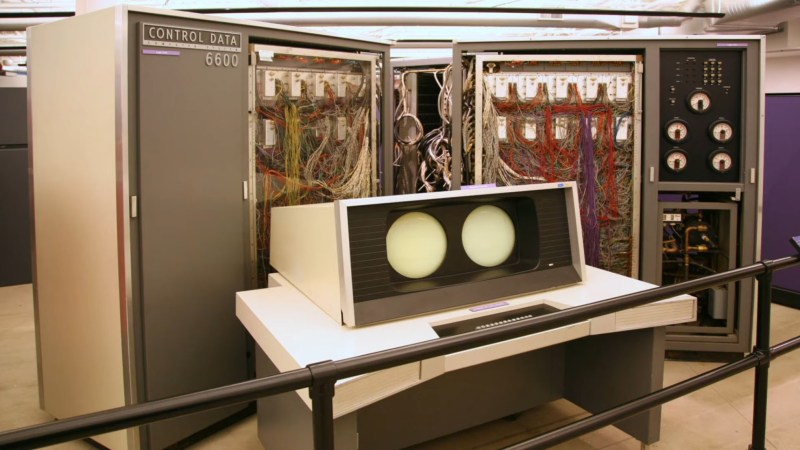The evolution of computer graphics is something that has been well documented over the years, and it’s a topic that we always enjoy revisiting with our retrocomputing readers. To wit, [Stephen A. Edwards] has put together an impressively detailed presentation that looks back at the computer graphics technology of the 1960s and 70s.
The video, which was presented during VCF East 2021, goes to great lengths in demystifying some of the core concepts of early computer graphics. There’s a lot to unpack here, but naturally, this retrospective first introduces the cathode-ray tube (CRT) display as the ubiquitous technology that supported computer graphics during this time period and beyond. Building from this, the presentation goes on to demonstrate the graphics capabilities of DEC’s PDP-1 minicomputer, and how its striking and surprisingly capable CRT display was the perfect choice for playing Spacewar!
As is made clear in the presentation, the 1960s featured some truly bizarre concepts in regards to cutting edge computer graphics, such as Control Data Corporation’s 6600 mainframe and accompanying vector-based dual-CRT video terminal, which wouldn’t look out of place on the Death Star. Equally strange at the time was IBM’s 2260 video data terminal, which used a ‘sonic delay line’ as a type of rudimentary video memory, using nothing but coiled wire, transducers and sound itself to store character information following a screen refresh.
These types of hacks were later replaced by solid state counterparts during the microcomputer era. The video concludes with a look back at the ‘1977 trinity’ of microcomputers, namely the Apple II, Commodore PET and TRS-80. Each of these microcomputers handled graphics in a slightly different way, and it’s in stark contrast to today’s largely homogenised computer graphics landscape.
There’s a lot more to this great retrospective, so make sure to check out the video below. When you’re finished watching, make sure to check out our other coverage of VCF 2021, including some great examples of computer preservation and TTL-based retrocomputing.
[With thanks to Stephen Walters for sending in the great tip]
















Missing a generation. Early displays also used storage tube displays. The tube itself is bistable and image remains (mostly) until erased. ARDS terminals used this. They also used U-core ROMS. Drive wire simply laid inside or outside the U allowed building your own characters. Much easier then threading a toroid. Lots of other displays not mentioned. https://www.evl.uic.edu/datsoupi/502/14_mach.pdf
https://en.wikipedia.org/wiki/Williams_tube
and don’t forget the tektronix storage displays in their tek 4002a: 3 bytes of memory and the rest is memorized by the screen fosfor itself. all vectors.
Back in the day, my father worked at Tektronix. When we were kids, we got to play games on those storage display terminals. Lunar lander, artillery, Star Terek, etc…
I think that was on a normal vector display as the refresh speed of the storage display was very slow.
https://m.youtube.com/watch?v=QZBQALjwdAg
Indeed, the ARDS having the distinction of being the first commercially available graphics terminal in the 1960s featuring a mouse as an option, along with a tablet and joystick.
Rememer the CRT monitors that drew the tactical information of enemy ships in the Vipers?
https://www.youtube.com/watch?v=1EF3nLhd26U&t=27
Displays with storage tube were used in the original ‘BattleStar Galactica’, too.
“In 1978 a number of Tektronix products including oscilloscopes, TM500 instruments, and 4051 computer graphic systems were used on the bridge of the television series Battlestar Galactica. This June 2, 1978 TekWeek featured information the show.”
https://vintagetek.org/tektronix-in-movies-shows/
https://secureservercdn.net/45.40.145.201/7vm.c31.myftpupload.com/wp-content/uploads/2017/12/BattlestarGalactica_TW_060291978.pdf
The dual vector scope on the Control Data 6600s was not cutting edge. They were actually pretty bad a drawing nice vectors. CDC had *much* better vector displays available for engineering use at the time. Other manufacturers also had bigger, better vector terminals available.
One could say the Control Data DD60 was one of the worst vector displays!
Hey uniservo, hope one day you get time to scan that unique SLT handbook that you showed a year or two back!
Now I feel old!
These days I program STM32F in Forth, but in my younger days I maintained lots of gear with those ‘sonic delay lines’ when I was doing datacomms.
They were nicely made, a number of turns of spring steel about 8″ in diameter with transducers at each end in a flat metal enclosure.
Beautiful American made quality as well. I’m still using parts I salvaged from that era, who would believe that there is 50 year old multicored wire that still works better than the brand new high quality wire that you can’t buy anymore?
https://mecrisp-stellaris-folkdoc.sourceforge.io/turret-pins.html#parts-equipment
I learned to program on an IBM1130. In my final year a graphic display screen was added. Although we had the maximum expanded memory version CPU, to light up all points would have taken exactly all the (core!) memory, leaving no room for a program.
You tell the kids of today and they don’t believe you!
Oooooh, this sparks a dim memory in my fuzzy brain! Back in the mid to late 1980s I had access to the DCTS – Dartmouth College Timeshare System. My Mom was an employee and all employees had accounts. Besides fooling around on ARPANET, etc. I would of course play games. Most games were text based like football, adventure (of some sort, not Zork), but there were a few terminals around campus that had vector graphics. On these you could play Missile Command and a couple other arcade type games. Wish I could remember what the terminals were called. Everything else was VT-100 based until 1984 when the whole campus went Macintosh!